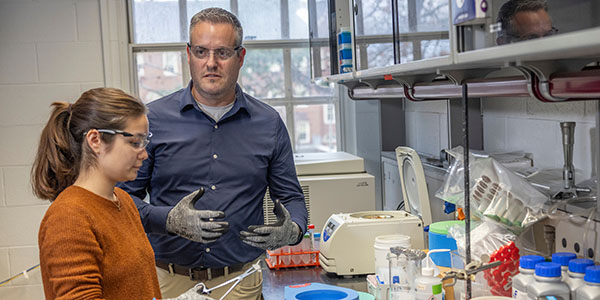Research, athletics both on display during Cure Bowl
Orlando college football event has generated more than $4.1 million in donations for cancer research since 2015

When Miami University takes the field on Dec. 16 at FBC Mortgage Stadium, more than just the RedHawks’ football team will be on display.
By virtue of their 11-2 record and Mid-American Conference championship, the RedHawks earned a place in the Cure Bowl opposite Appalachian State. First played in 2015, the Cure Bowl also serves as a platform to promote awareness for cancer research. More than $4.1 million in donations has been raised since its initial outing.
As part of the festivities, a 30-second commercial spotlighting Miami’s research efforts will air during the broadcast.
“It really shows all the people who are watching the game that the university is more than just sports. The university is more than just teaching and research. All of those things coming together are important,” said Rick Page, Miami’s associate vice president of research and innovation and professor of Chemistry and Biochemistry. “All of these things tie together our mission to take students and create individuals who are going to go out and change the world.”
Page was interviewed for the video, along with members of his lab group including graduate student Shreesti Shrestha, Kei Brown, senior Biochemistry and French double major, and Angela Cupo, senior Biochemistry major who graduates this month.
Like many others, Page has a personal connection to cancer research. He had three grandparents pass away from cancer.
“I’ve seen how challenging and devastating it is,” Page said. “It strikes a personal tone.”
“Miami’s cancer research runs the gamut from discovery science to translational,” Page said, “including identifying molecules that impact pathways involved with cancer and learning from the proteins and different genes that cause various cancers to evade treatment.”
Brown’s research project focuses on antibiotic resistance.
“Working on this research really makes me feel like I’m a part of something bigger,” Brown said.
So does the collaboration between Miami’s students, staff, and faculty. Page, too, praised the collaborative effort when it comes to research, noting the impact it has across different disciplines at the university.
Miami set a new record for extramural funding for fiscal year 2023, continuing a trend established over the past six years, reported the office of research and innovation.
“One of the things that is exciting is Miami is emerging as a research institution,” Page said. “The university is investing in and driving forward research. Our faculty, staff, and students are getting grants from national institutions, all sorts of federal and private funders, and it’s allowing our people to do really tremendous work. It’s an exciting time.”